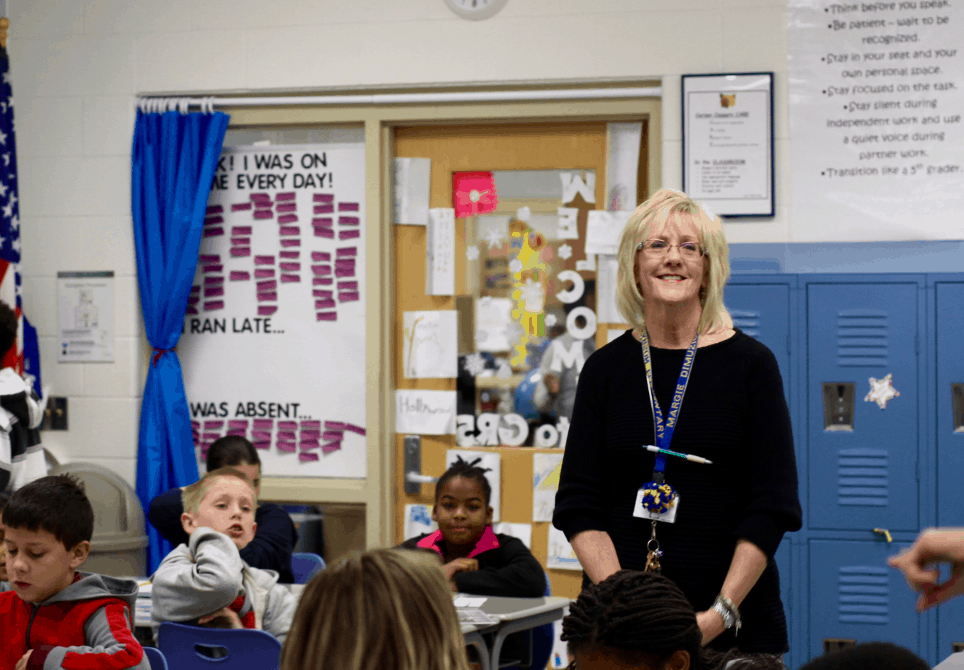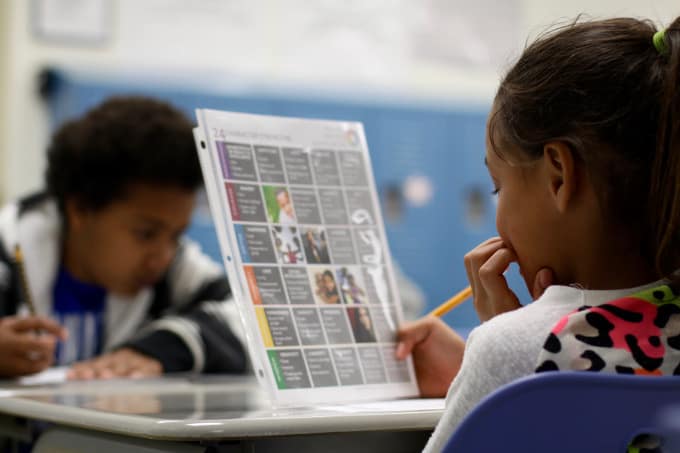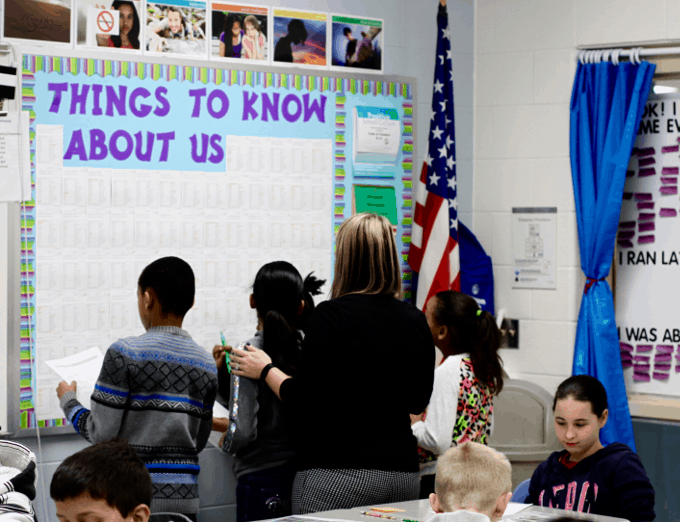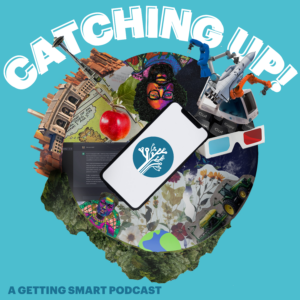How 2 Minutes of SEL Can Change the Tone for the Day

What if two-minutes could change the tone of the classroom for the entire day? By building on strengths and targeting Social Emotional Learning (SEL) strategies, two-minutes CAN change an attitude and make the day–for students and teachers.
We had the opportunity to see this in action when we visited Margie DiMuzio and Brittany Noble’s classroom at Carson K-8 School in Cincinnati Public Schools, an innovative blended approach to teaching SEL.
Within the first couple minutes of the day (right after the quiet and systematic pencil-sharpening process), students were identifying and affirming character strengths in not only themselves, but also in their classmates and teachers.
As if it were as natural as saying “My favorite food is pizza,” a 5th grade boy reflected, “One of my best strengths is social intelligence because I know strong relationships are important for a happy life.”
Another student was eager to say, “I appreciate that Mrs. Noble shows the character strength of hope when she expects our best every day.”
It doesn’t take more than two-minutes to make comments like that, and it doesn’t take much more than a commitment to implementing these practices to make strength-based SEL a reality in your classroom or school.
This process, part of an advisory lesson, is based on a character strengths assessment students and teachers had previously completed through the Happify platform as part of Mayerson Academy’s Thriving Learning Communities (TLC)program . This initiative aligns well with the district advisory program and takes it to the next level by providing an engaging, blended approach that leverages the contributions of each partner.
Positive Partnerships. Cincinnati-based Mayerson Academy is collaborating not only with the district, but also with Happify and VIA Institute on Character, to implement TLC with Happify in 41 Cincinnati schools and others around the country. Mayerson Academy specializes in designing learning experiences for improved performance – in this case, building upon the science of character strengths and well-being. President Jillian Darwish reflects:
Our core purpose is to improve performance through extraordinary learning experiences. With this initiative, we work with school and classroom leaders to establish a strengths-based culture that supports the development of social emotional learning competencies which we know will catalyze the best possible learning environment for all learners. This partnership strategically provides the structure, tools, coaching and research base to make it happen.
Research-Based. The TLC with Happify program is a research-based approach to improving students’ social and emotional competencies through revealing and catalyzing individual strengths that motivate learners of all ages (students and teachers alike). The character strengths inventory, along with classroom and Happify activities, provide a common language for students, educators, teams, and leaders to identify and affirm what is best in themselves and others.
Rather than prescribing a particular recipe for positive character, this approach builds on strengths. When students made their “first two-minutes comments,” they drew from the 24 character strengths that are part of the online assessment.

Not only are the strengths grounded in research, so are the Happify games and activities. For example, negative knockout is an ‘angry birds’ like game where you choose your biggest challenges that day (procrastination, irritability) and destroy those words with a slingshot. It draws from a 2012 Ohio State University study. [insert happify image]
Advisory Process. We know how important advisory is to personalizing the school experience. The TLC with Happify program? can work within the broader framework of any system’s existing advisory structure – or can provide a great place to start for those just beginning. For example, TLC with Happify is implemented in concert with CPS’ My Tomorrow advisory program.
Karen Graves, Mayerson’s Learning and Engagement Designer who oversees implementation, articulates Cincinnati’s middle-level advisory program goal, “We seek to create a space where every student has the opportunity to feel known, be heard and be understood.” Advisory focuses on four main areas:
- creating community
- academic advising
- social-emotional learning,
- post-secondary planning.
The process is made fun through the Happify game-based approach to teaching SEL and made easy through a Thriving Classroom curriculum guide that provides blended lessons and activities.
Schoolwide Culture. Assistant Principal Ross Turpeau, says, “We are always looking for more ways to establish a meaningful connection with kids. This is the perfect product to fill a missing gap.” Assistant Principal Al Beauchamp sees it as a professional development opportunity and a catalyst for staff conversations about creating a welcoming environment. He reflects, “It hurts me when a student says, ‘I don’t want to be here.’ We believe we’re providing a welcoming environment and a great set of learning experiences, yet something must be off if some kids don’t want to be here.
The school leadership team is committed to persistently pursuing a positive culture and knows that when we know about kids strengths, we can help them feel connected.

Long-Term Benefits. Indicators point to a great ROI on investing in strengths – not just for the day, but for years. University of Florida’s Jim Judge and Charlie Hurst studied self-evaluations of over 7,000 men and women starting in 1979,when they were teenagers. They followed participants for the next 25 years with questions about education, health, career success, and job status.
Their findings were profound – people with higher confidence showed advantages in the areas measured. For example, those with higher confidence reported better physical health 25 years later (those with lower confidence at three times as many health problems). Results also held true for income levels and career satisfaction. As reported in Strengths-Based Leadership, a follow up study by Gallup showed that people who had the opportunity use their strengths early on (ages 15-23) had significantly higher job satisfaction and income levels 26 years later. In summary, there is a cumulative, and often exponential, benefit for people who are aware of their strengths and develop self-confidence at a young age.
How about you? Whether seeking to change a day, change a life, or both, building on strengths in a practical, fun and engaging way makes sense. Whose day can you make today?
Mayerson Academy and its partners provide a deep, yet practical, “SEL-in-a-box” approach and are sure to shape the conversation. For more information, please visit TLC with Happify.
https://youtu.be/8KBQBj704D8
For more
- Happify: The Science of Well-being
- The Role of Advisory in Personalizing Secondary Experience
- Social Emotional Learning in Action: How a Leading District Responded to the Community’s Clarion Call
- Personalizing and Guiding College and Career Readiness
Stay in-the-know with all things EdTech and innovations in learning by signing up to receive the weekly Smart Update. This post includes mentions of a Getting Smart partner. For a full list of partners, affiliate organizations and all other disclosures please see our Partner page.







John Sutherland
Very well done article by Carri and Mary on innovative programs
analytic
Excellent blog! Do you have any tips for aspiring writers?
I'm planning to start my own blog soon but I'm a little
lost on everything. Would you recommend starting with a
free platform like Wordpress or go for a paid
option? There are so many options out there that I'm totally
overwhelmed .. Any recommendations? Many thanks!
Jane Hardin
Great article!